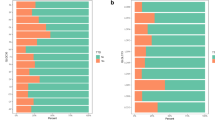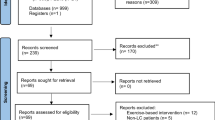Abstract
Purpose
To investigate the relationship between physical activity (PA) and quality of life (QOL) among patients with respiratory and digestive system cancers during and outside of the COVID-19 pandemic.
Methods
A longitudinal, repeated-measures observational design was employed, and data were collected from outpatient clinics and wards during both the pandemic and a nonpandemic period at baseline (T1) and 3 months postrecruitment (T2). The Bouchard 3-Day Physical Activity Record questionnaire and the European Organisation for Research and Treatment of Cancer (EORTC) Quality of Life Core Questionnaire (physical function subscale) were used to measure PA and QOL, respectively.
Results
A total of 313 patients with various cancers (including lung, esophageal, gastric, pancreatic, and colon cancers) participated in this study. Light-intensity PA was significantly and positively correlated with the physical function dimension of QOL during both the pandemic (r = 0.31, p < 0.001) and nonpandemic (r = 0.15, p = 0.010) periods. Furthermore, light-intensity PA was a significant predictor of the physical function dimension of QOL during both the pandemic and nonpandemic periods (B = 0.04, p < 0.001; B = 0.02, p = 0.007, respectively).
Conclusions
Light-intensity PA is a critical predictor of the physical function domain of QOL in patients with respiratory and digestive system cancers during both pandemic and nonpandemic periods. Promoting engagement in tolerable PA may improve the health of these patients.

Similar content being viewed by others
Data Availability
Data are available from the corresponding author upon reasonable request.
References
Siegel RL, Miller KD, Wagle NS, Jemal A (2023) Cancer statistics, 2023. CA Cancer J Clin 73:17–48
Liao J, Wang Y, Dai W, Wei X, Yu H, Yang P, Xie T, Li Q, Liu X, Shi Q (2022) Profiling symptom burden and its influencing factors at discharge for patients undergoing lung cancer surgery: a cross-sectional analysis. J Cardiothorac Surg 17:229
Mello MRSPd, Moura SF, Muzi CD, GuimarÃes RM (2020) Clinical evaluation and pattern of symptoms in colorectal cancer patients. Arq Gastroenterol 57:131–136
Hendifar AE, Petzel MQB, Zimmers TA, Denlinger CS, Matrisian LM, Picozzi VJ, Rahib L (2019) Pancreas cancer-associated weight loss. Oncologist 24:691–701
Duineveld LAM, Wieldraaijer T, Govaert MJ, Busschers WB, Wind J, van Asselt KM, van Weert HC (2022) Symptoms and seeking supportive care and associations with quality of life after treatment for colon cancer: results from the I CARE cohort study. Eur J Cancer Care 31:e13601
Campbell KL, Winters-Stone KM, Wiskemann J, May AM, Schwartz AL, Courneya KS, Zucker DS, Matthews CE, Ligibel JA, Gerber LH, Morris GS, Patel AV, Hue TF, Perna FM, Schmitz KH (2019) Exercise guidelines for cancer survivors: consensus statement from international multidisciplinary roundtable. Med Sci Sports Exerc 51:2375–2390
Cuda N, Tabaczynski A, Bastas D, Whitehorn A, Ghazinour G, Trinh L (2024) Associations of changes in physical activity and well-being among cancer survivors during the COVID-19 pandemic. Adv Exerc Health Sci 1(3):178–186
Rossi A, Garber CE, Kaur G, Xue X, Goldberg GL, Nevadunsky NS (2017) Physical activity-related differences in body mass index and patient-reported quality of life in socioculturally diverse endometrial cancer survivors. Support Care Cancer 25:2169–2177
Tabaczynski A, Bastas D, Whitehorn A, Trinh L (2023) Changes in physical activity and associations with quality of life among a global sample of cancer survivors during the COVID-19 pandemic. Journal of Cancer Survivorship 17:1191–1201
Sohrabi C, Alsafi Z, O’neill N, Khan M, Kerwan A, Al-Jabir A, Iosifidis C, Agha R (2020) World Health Organization declares global emergency: a review of the 2019 novel coronavirus (COVID-19). International journal of surgery 76:71–76
Motton S, Vergriete K, VanPhi LN, Lambaudie E, Berthoumieu A, Pous J, Delannes M, Piscione J, Cornou C, Bataille B (2022) Evaluation of the impact of the COVID-19 lockdown on the quality of life of patients monitored for cancer who practice an adapted physical activity: rugby for health. J Cancer Res Clin Oncol 148:425–439
Larkin J, Vanzella L, Thomas S, Colella TJ, Oh P (2022) Breast cancer survivors’ physical activity and experiences while transitioning to a virtual cardiovascular rehabilitation program during a pandemic (COVID-19). Supportive Care in Cancer 30:7575–7586
Urbano Chamorro I, de la Torre-Montero JC (2024) Cancer-related fatigue and activities of daily living: lessons learned from the COVID-19 pandemic. BMC Palliative Care 23:110
Faro JM, Mattocks KM, Nagawa CS, Lemon SC, Wang B, Cutrona SL, Sadasivam RS (2021) Physical activity, mental health, and technology preferences to support cancer survivors during the COVID-19 pandemic: cross-sectional study. JMIR Cancer 7:e25317
Centers for Disease Control Taiwan (2020) Two experts from Taiwan visit Wuhan to understand and obtain information on severe special infectious pneumonia outbreak; Taiwan CDC raises travel notice level for Wuhan to Level 2. Publish https://www.cdc.gov.tw/En/Bulletin/Detail/jFGUVrlLkIuHmzZeyAihHQ?typeid=158
Centers for Disease Control Taiwan (2023) Effective May 1, COVID-19 to be downgraded to Category 4 notifiable communicable disease and CECC to disband; Ministry of health and welfare to take charge of relevant preparation and response work Taiwan Centers for Disease Control. Publish https://www.cdc.gov.tw/En/Bulletin/Detail/FW_1qpr_nCJoo0X1X5oDCw?typeid=158
Bouchard C, Tremblay A, Leblanc C, Lortie G, Savard R, Thériault G (1983) A method to assess energy expenditure in children and adults. Am J Clin Nutr 37:461–467
Wickel EE, Welk GJ, Eisenmann JC (2006) Concurrent validation of the Bouchard diary with an accelerometry-based monitor. Med Sci Sports Exerc 38:373–379
Lu CM, Lin SL, Huang YC, Lee MH, Wang SF (2001) A study on validity and reliability of self-report measures of physical activity: using TriTrac-R3D accelerometer as criterion. Journal of Health Education (Chinese) 15:99–114
Chen HM, Wu YC, Tsai CM, Tzeng JI, Lin CC (2015) Relationships of circadian rhythms and physical activity with objective sleep parameters in lung cancer patients. Cancer Nurs 38:215–223
Aaronson NK, Ahmedzai S, Bergman B, Bullinger M, Cull A, Duez NJ, Filiberti A, Flechtner H, Fleishman SB, de Haes JC et al (1993) The European Organization for Research and Treatment of Cancer QLQ-C30: a quality-of-life instrument for use in international clinical trials in oncology. Journal of the National Cancer Institute 85:365–376
Faul F, Erdfelder E, Lang AG, Buchner A (2007) G*Power 3: a flexible statistical power analysis program for the social, behavioral, and biomedical sciences. Behavior research methods 39:175–191
Bates-Fraser LC, Riley S, Stopforth C, Moertl K, Edgar K, Stoner L, Hanson ED (2023) Home-based exercise improves quality of life in breast and prostate cancer survivors: a meta-analysis. Plos One 18:e0284427
Sharma H, Pankratz VS, Demark-Wahnefried W, Pestak CR, Blair CK (2022) Association between quality of life and physical functioning in a gardening intervention for cancer survivors. Healthcare (Basel)10:1421–1434
Tison GH, Avram R, Kuhar P, Abreau S, Marcus GM, Pletcher MJ, Olgin JE (2020) Worldwide effect of COVID-19 on physical activity: a descriptive study. Annals of internal medicine 173:767–770
Castellanos-Montealegre M, Rivera-Theruel F, García-Coll V, Rioja-Collado N, Gil-Herrero L, López-Tarruella S, Montealegre Sanz M, Cerezo González S, Fernández Aramburo A, Ruiz-Casado A (2023) Impact of the COVID-19 lockdown on physical activity levels and health parameters in young adults with cancer. Current Oncology 30:5395–5408
Lopez-Sanchez GF, Lopez-Bueno R, Gil-Salmeron A, Zauder R, Skalska M, Jastrzebska J, Jastrzebski Z, Schuch FB, Grabovac I, Tully MA (2021) Comparison of physical activity levels in Spanish adults with chronic conditions before and during COVID-19 quarantine. European journal of public health 31:161–166
Belloum Y, Rannou-Bekono F, Favier FB (2017) Cancer-induced cardiac cachexia: pathogenesis and impact of physical activity (Review). Oncol Rep 37:2543–2552
Stone P, Candelmi DE, Kandola K, Montero L, Smetham D, Suleman S, Fernando A, Rojí R (2023) Management of fatigue in patients with advanced cancer. Curr Treat Options Oncol 24:93–107
Li CQ, Wang YC, Shen SQ, Zhang YL, Zhao JQ, Zou WB, Ge RL (2023) Effects of exercise by type and duration on quality of life in patients with digestive system cancers: a systematic review and network meta-analysis. J Sport Health Sci 12:491–500
Furtado GE, Letieri RV, Caldo-Silva A, Sardao VA, Teixeira AM, de Barros MP, Vieira RP, Bachi ALL (2021) Sustaining efficient immune functions with regular physical exercise in the COVID-19 era and beyond. European Journal of Clinical Investigation 51:e13485
Filgueira TO, Castoldi A, Santos LER, de Amorim GJ, de Sousa Fernandes MS, Anastácio WdLdN, Campos EZ, Santos TM, Souto FO (2021) The relevance of a physical active lifestyle and physical fitness on immune defense: mitigating disease burden, with focus on COVID-19 consequences. Frontiers in immunology 12:587146
Khosravi N, Stoner L, Farajivafa V, Hanson ED (2019) Exercise training, circulating cytokine levels and immune function in cancer survivors: a meta-analysis. Brain, behavior, and immunity 81:92–104
Ghram A, Briki W, Mansoor H, Al-Mohannadi AS, Lavie CJ, Chamari K (2021) Home-based exercise can be beneficial for counteracting sedentary behavior and physical inactivity during the COVID-19 pandemic in older adults. Postgraduate medicine 133:469–480
Fardman A, Banschick GD, Rabia R, Percik R, Fourey D, Segev S, Klempfner R, Grossman E, Maor E (2021) Cardiorespiratory fitness and survival following cancer diagnosis. European journal of preventive cardiology 28:1242–1249
Scott JM, Zabor EC, Schwitzer E, Koelwyn GJ, Adams SC, Nilsen TS, Moskowitz CS, Matsoukas K, Iyengar NM, Dang CT (2018) Efficacy of exercise therapy on cardiorespiratory fitness in patients with cancer: a systematic review and meta-analysis. J Clin Oncol 36:2297–2305
Gilchrist SC, Barac A, Ades PA, Alfano CM, Franklin BA, Jones LW, La Gerche A, Ligibel JA, Lopez G, Madan K (2019) Cardio-oncology rehabilitation to manage cardiovascular outcomes in cancer patients and survivors: a scientific statement from the American Heart Association. Circulation 139:e997–e1012
Farah E, El Bizri M, Day R, Matai L, Horne F, Hanna TP, Armstrong D, Marlin S, Jérôme O, Brenner DR (2022) Report from the ready for the next round thought-leadership roundtables on building resilience in cancer care and control in Canada-colorectal cancer Canada. Curr Oncol 29:1723–1743
Bayyat MM, Amarin R, AlDabbas H, Akkawi M (2024) Quality of life and physical activity levels among colorectal cancer patients: an observational study. Medicine 103:e38778
Funding
This study received support from the National Science and Technology Council of Taiwan (grant no. NSTC 113–2314-B-227–007-MY3).
Author information
Authors and Affiliations
Contributions
Hui-Mei Chen: Conceptualization, data curation, formal analysis, investigation, funding acquisition, methodology, validation, resources, visualization, supervision, project administration, roles/writing—original draft, review, and editing. Jiu-Yun Tian: Data curation, roles/writing—original draft, review, and editing. Wei-Ling Gao: Data curation, investigation, visualization, roles/writing—review and editing. Zih-Yun Deng: Data curation, investigation, visualization, roles/writing—review and editing. Pei-Shan Ho: Data curation, investigation, roles/writing—review and editing. Yi-Yun Lin: Data curation, investigation, roles/writing—original draft, review and editing.
Corresponding author
Ethics declarations
Ethics approval and consent to participate
This study adhered to the principles of the Declaration of Helsinki and was approved by the Institutional Review Board of the Taipei Veterans General Hospital, Taipei, Taiwan (Study ID Number: VGHIRB 98–12-15A for lung cancer; TPEVGH IRB 2017–04-001A for esophageal cancer; TPEVGH IRB 2020–10-006A for gastric cancer; and TPEVGH IRB 2021–12-005A for pancreas cancer), and Research Ethics Committee D of National Taiwan University Hospital, Taipei, Taiwan (Study ID Number: NTUH-REC 110–146-E). All patients provided informed consent prior to the study and were informed that they were free to withdraw for any reason.
Competing interests
The authors declare no competing interests.
Additional information
Publisher's Note
Springer Nature remains neutral with regard to jurisdictional claims in published maps and institutional affiliations.
Supplementary Information
Below is the link to the electronic supplementary material.
ESM 1
(PDF 27.6 KB )
Rights and permissions
Springer Nature or its licensor (e.g. a society or other partner) holds exclusive rights to this article under a publishing agreement with the author(s) or other rightsholder(s); author self-archiving of the accepted manuscript version of this article is solely governed by the terms of such publishing agreement and applicable law.
About this article
Cite this article
Chen, HM., Tian, JY., Gao, WL. et al. Relationship between physical activity and quality of life among patients with respiratory and digestive system cancer during and outside the COVID-19 pandemic. Support Care Cancer 33, 288 (2025). https://doi.org/10.1007/s00520-025-09334-8
Received:
Accepted:
Published:
DOI: https://doi.org/10.1007/s00520-025-09334-8




